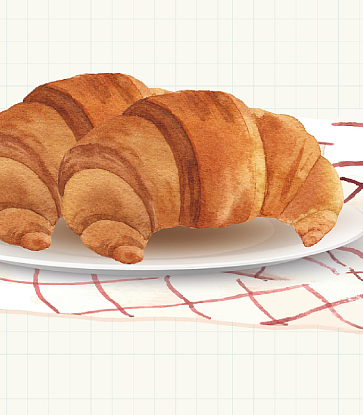To be sure, the French have gotten the art of making pastries down pat. From flaky croissants to delicate macarons, a common thread that links them all is the burst of rich flavour that comes with every bite. Here, we take a look at eight different types.

The key to this flaky viennoiserie: a good butter (preferably from Normandy) with a high melting point that makes all the difference when it comes to layering. A stellar croissant should have a beautiful cross section boasting a honeycombed interior when sliced in half. Best eaten plain, though day-old croissants are good for making almond variations.
2. Baguette
This loaf usually gets a bad reputation for being too hard for Asian palates. But a good baguette made using just flour, water, yeast and salt is best eaten when it is made on the day itself so you get to savour its resilient crumb and bronzed skin. Best eaten with a smear of good butter.
3. Madeleines
These French tea cakes have a distinctive shell shape with a little bump on one side that makes them stand out. It is made with just eggs, plain flour, sugar and a whole lot of butter, and usually enjoyed with a cup of tea.

This sweet meringue-based confection has sparked countless debates on how its name is spelt — macaron, macaroon.
Made with egg whites, icing sugar, granulated sugar, almond powder or ground almond, the macaron usually consists of a ganache, buttercream or jam filling sandwiched between two delicate shells.
It should be easy to pick out this pastry at one glance. Shaped like a bicycle wheel, a Paris-Breast is traditionally made from a ring of choux pastry filled with a praliné mousseline cream and dusted with icing sugar.
6. St. Honoré
St. Honoré, or Gâteau St. Honoré, starts out with a circle of puff pastry as a base. On top of this, a baker will then pipe a ring of pâte à choux (a light pastry dough). This creates a well that is then filled with pastry cream and topped with petite cream puffs dipped in sugar — a characteristic feature of this sweet treat.

This round crusty cake is often compared to puff pastry, as it uses the same method of folding in layers of butter and sugar with bread dough. Pronounced kween-ah-mon, think of this as a denser version of a croissant, only the kouign-amann has that extra step of being dusted with sugar.
8. Mille-feuille
The beauty of this French pastry lies in its layers. The mille-feuille is a work of patience; bakers work by layering puff pastry with pastry cream and repeating the process at least thrice to form this dessert. The top layer is then dusted with sugar and sometimes cocoa powder, or glazed with fondant for a fancier touch.





















